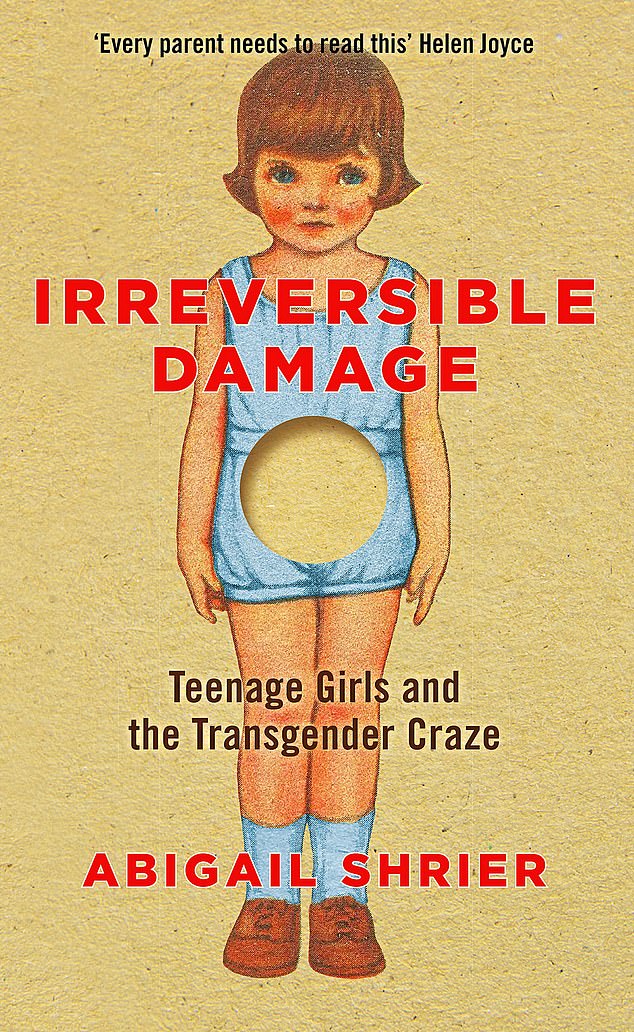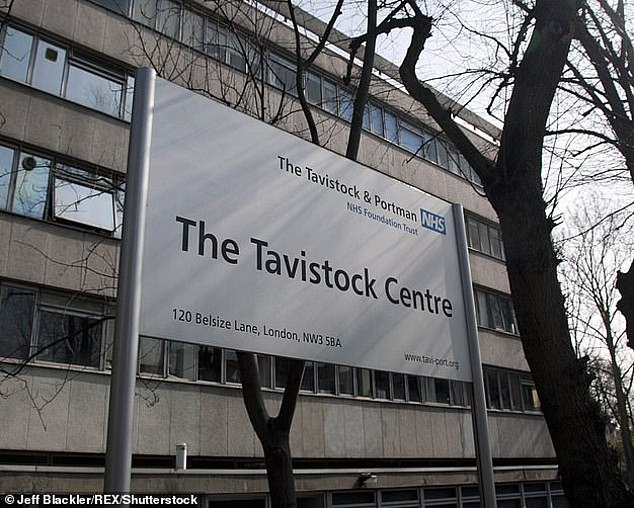ABIGAIL SHRIER'S investigation into the exploding numbers of girls wanting to change sex
The increasing number of young girls wanting to switch gender has become an explosive subject as parents, scientists and campaigners warn of the irreversible, life-changing dangers.
When ABIGAIL SHRIER, a writer for the Wall Street Journal, investigated the issue for a book, her first prospective publisher pulled out following protests by staff.
Then, amid a furious row over free speech, an English professor at one of America’s top universities suggested the book should be burned.
And when Shrier was interviewed for a podcast hosted by Spotify, staff at the streaming giant threatened to walk out.
And although Amazon sells her book, it has refused to let Shrier’s publisher buy online adverts.
In face of these attempts at censorship, Shrier has condemned what she calls ‘tyranny’s advance’, saying: ‘This is what censorship looks like in 21st Century America.
‘It isn’t the government sending police to your home.
‘It’s Silicon Valley oligopolists implementing blackouts and appeasing social-justice mobs, while sending disfavoured ideas down memory holes.
‘And the forces of censorship are winning.’
Lucy had always been a ‘girly girl’, her mother told me. As a child, she loved high heels and frilly dresses.
Dressing up was a favourite game, and she had a trunk full of gowns and wigs she would dip into, inhabiting an assortment of characters – every one of them female.
She adored Disney princess movies, especially The Little Mermaid.

ABIGAIL SHRIER is a writer for the Wall Street Journal
Lucy was precocious, reading early. But by 11, her anxiety spiked. The waters of depression rushed in.
Her affluent parents took her to psychiatrists and therapists, but no amount of talking therapy or drugs levelled her social obstacles: the cliques that didn’t want her or her tendency to fluff social tests casually administered by other girls.
Boys gave her less trouble, and she had male friends and boyfriends throughout school. Lucy’s ups and downs eventually resolved in a bipolar diagnosis.
Arriving at university, she was invited to state her name, sexual orientation and gender pronouns.
Lucy spotted the new opportunity of social acceptance, a whiff of belonging.
When her anxiety flared later that autumn, she decided, with several of her friends, that their angst had a fashionable cause: gender dysphoria – a distressing mismatch between one’s birth sex and the person they feel they are.
Within a year, Lucy had begun a course of testosterone. But her real drug was the promise of a new identity.
A shaved head, boys’ clothes, and a new name formed the baptismal waters of a female-to-male rebirth.
The next step would be ‘top surgery,’ a euphemism for a double mastectomy.
I came across Lucy’s story after writing in the Wall Street Journal about the new laws on the use of gender pronouns, under the headline The Transgender Language War.
In October 2017, my state, California, had enacted a law backed by possible jail sentences for healthcare workers who refused to use patients’ requested gender pronouns.
New York had adopted a similar law, which applied to employers, landlords and businesses.
Both laws are unconstitutional, violating the First Amendment’s guarantee of free speech.

The increasing number of young girls wanting to switch gender has become an explosive subject as parents, scientists and campaigners warn of the irreversible, life-changing dangers. When Ms Shrier investigated the issue for a book, her first prospective publisher pulled out following protests by staff
Lucy’s mother saw my article and found something in it: hope. She contacted me under a pseudonym and asked me to write about her daughter.
When I asked if she was sure Lucy wasn’t feeling gender dysphoria, she explained that her daughter had ‘never even expressed any discomfort over her body… and she’d always dated boys’.
She said Lucy had discovered this identity with the help of the internet, which provides an endless array of transgender mentors who coach adolescents in the art of slipping into a new gender identity – what to wear, how to walk, what to say.
Which online companies sell the best breast binders (a breast-compression garment, worn under clothes); which organisations send them for free and guarantee discreet packaging so that parents never find out; how to persuade doctors to supply the hormones you want; how to deceive parents – or, if they resist your new identity, how to break away entirely.
Gender dysphoria is characterised by a severe and persistent discomfort in one’s biological sex.
It typically begins in early childhood, ages two to four, though it may grow more severe in adolescence.
But in nearly 70 per cent of cases,
childhood gender dysphoria resolves.
Historically, it afflicted about 0.01 per cent of the population, and almost exclusively boys.
Before 2012, there was no scientific literature on girls aged 11 to 21 ever having developed gender dysphoria.
In the past decade, that has changed dramatically.
The Western world has seen a sudden surge of adolescents claiming to have gender dysphoria and self-identifying as transgender.
In Britain, Canada, Sweden and Finland, clinicians and gender therapists began reporting a dramatic shift in the demographics of those presenting with gender dysphoria, from predominately pre-school-aged boys to predominately adolescent girls.
In Britain, in 2018, there was a 4,400 per cent rise over the previous decade in teenage girls seeking gender treatments.
Between 2016 and 2017, the number of gender-reassignment surgeries for girls in the US quadrupled, with people born female suddenly accounting for 70 per cent of all such operations.
Why? What happened? How did the sex ratio flip, from overwhelmingly boys to majority adolescent girls?

In Britain, in 2018, there was a 4,400 per cent rise over the previous decade in teenage girls seeking gender treatments. Pictured: The NHS’s London gender clinic, the Tavistock Centre
I was an opinion writer, not an investigative reporter, so I put Lucy’s mother in touch with another journalist.
But her story remained stubbornly lodged in my brain. Three months later, I got back in touch with her.
I spoke to endocrinologists – doctors who specialise in glands and hormones – psychiatrists, world-renowned psychologists specialising in gender dysphoria, psychotherapists, transgender adolescents and transgender adults.
The more I learned about the adolescents who suddenly identify as transgender, the more haunted I became by one question: what’s ailing these girls?
In January 2019, the Wall Street Journal ran my article, When Your Daughter Defies Biology.
I was flooded with emails from readers who had experienced with their own children the phenomenon I had described, or had witnessed its occurrence at their children’s schools – clusters of adolescents, suddenly discovering transgender identities together, begging for hormones, desperate for surgery.
Transgender activists attacked me online, so I offered them the opportunity to tell me their stories.
I spoke to anyone who had something to offer on this issue. Their responses formed the basis of my book about the transgender craze.
I conducted nearly 200 interviews and spoke to more than four dozen families of adolescents, as well as transgender adults – those who present as women and those who present as men.
Indeed, some small proportion of the population will always be transgender.
They describe the relentless chafe of a body that feels all wrong, a feeling that has dogged them for as long as they can remember.
They are kind, thoughtful and decent. For their honesty and courage, they easily won my admiration.
They have very little to do with the current trans epidemic plaguing teenage girls.
Closer to the mark are the Salem witch trials of the 17th Century, the nervous disorders of the 18th Century, and anorexia nervosa, repressed memory, bulimia and the self-harm contagion in the 20th Century.
At the forefront of all this are adolescent girls. Their distress is real, but their self-diagnosis is flawed – more the result of encouragement and suggestion than psychological necessity.
Three decades ago, these girls might have hankered for liposuction.
Two decades ago, they might have ‘discovered’ a repressed memory of childhood trauma or multiple personality disorder.
Today’s diagnostic craze isn’t demonic possession – it’s gender dysphoria.
For these girls, trans identification offers freedom from anxiety, it satisfies their deep need for acceptance, along with the thrill of transgression, egged on by their peers, therapists, teachers and internet influencers.
And its ‘cure’ is not exorcism or purging. It’s testosterone and ‘top surgery’: a lifetime of hormone dependency and disfiguring surgeries.
No adolescent should pay this high a price for having been, briefly, a follower of this contagion.
The fact is, as a population, adolescent girls today are in a lot of pain.
Teenagers are in the midst of a mental health crisis, evincing record levels of anxiety and depression and self-harm.
The number diagnosed with clinical depression grew by 37 per cent between 2005 and 2014.
And the worst hit, experiencing depression at a rate three times that of boys, were teenage girls.
Why the sudden spike?
Social media is one answer. Anorexia, self-harm and suicide have all increased dramatically since the arrival of the smartphone.
Posting online one’s experiences with any of these afflictions offers the chance to win hundreds, even thousands, of followers. Identifying as transgender offers the same.
Many adolescent girls who fall for the transgender craze lead upper-middle-class lives.
They are often top-grade students, notable for their agreeableness, companionability and utter lack of rebellion.
They’ve never smoked a cigarette, they don’t ever drink. They’ve also never been sexually active. Many have never had a kiss. Their bodies are a mystery to them.
Anxious, depressed, awkward and afraid, they sense a dangerous chasm between the unsteady girls they feel they are, and the glamorous women social media tells them they should be. Bridging that gap feels hopeless.
Pornography also plays a role. Violent porn – readily available to children on platforms such as Pornhub – terrifies young girls about men and the prospect of sex with them.

Violent porn – readily available to children on platforms such as Pornhub – terrifies young girls about men and the prospect of sex with them
Sasha Ayad, a therapist whose practice is largely devoted to trans-identifying adolescents, says: ‘The kids that I work with are often pretty freaked out by porn… In some cases, porn played a big role in their new adopted identity.’
Many adolescent girls identifying as transgender don’t actually want to become men.
They simply want to flee womanhood like a house on fire, their minds fixed on escape, not on any particular destination.
They feel alienated from their bodies and the changes brought by puberty: acne, periods and breast development and uncomfortable attention from men.
They might be forgiven for adopting the contemporary creed: ‘There must be a pill for this.’
After all, there is a pill for all ills – Ritalin for inattention, opioids for pain, Xanax for nerves. Testosterone for female puberty.
Among the parents who contracted me were two lesbian mothers with a daughter, Julie.
A talented ballet dancer, she was ‘pretty girly and feminine, with no history of gender dysphoria, either as a child or even through puberty’.
That is until Julie joined the GayStraight Alliance, a popular club at school, although she identified as straight. There, she met Lauren, and Julie seemed in thrall to her.
When Lauren came out as transgender, Julie toyed with adopting that identity, too, unknown to her mothers.
Without their knowledge, Julie’s teachers and friends all began referring to her as a male student and by her new male name.
Julie began to lead a kind of double life. Her parents did not know that she was intensively watching trans influencers on YouTube.
But they sensed their daughter was slipping away.
At 18, Julie moved out, began a course of testosterone and abruptly cut off contact with her parents.
It was only through a friend who followed Julie’s Instagram account that they learned she’d undergone a double mastectomy.
They saw a picture of her, straight after her surgery, lying in the hospital bed ‘talking about how this is the best day of her life… and 400 of her [internet] cheerleaders saying, ‘Yay’, ‘Awesome job’, ‘We’re so proud of you’ ‘.
Like freezing your eggs, blocking puberty with drugs is presented to young women as simply allowing them to put nature on hold while keeping their options open – a neutral, low-risk intervention.
But is it?
A teenage girl whose body does not go through the same biological changes as her peers’ is likely to feel more alone, more alienated from womanhood – not less.
No surprise, then, that in a clinical trial, 100 per cent of children put on puberty blockers moved on to cross-sex hormones.
That is a stunning statistic, especially considering that when no intervention is made, roughly 70 per cent of children will outgrow gender dysphoria, contradicting the claim of activists that gender identity is innate and ‘immutable’.
Aside from alienation, there are multiple physical dangers from taking puberty blockers: suppression of normal bone density development and greater risk of osteoporosis, loss of sexual function, interference with brain development and possibly suppressing peak IQ.
If an adolescent moves straight from puberty blockers to cross-sex hormones, infertility is almost guaranteed. And what effect do sex hormones, such as testosterone, have?
In 2007, there was one gender clinic in the US. Today, there are more than 50, many prescribing testosterone to girls on their first visit on an ‘informed consent’ basis, with no referral or therapy required.
For some girls, testosterone can feel like nothing short of a miracle: it suppresses anxiety and even lifts depression and makes it harder to cry.
But there are physical effects. After some months on testosterone, a young woman’s voice will start to crack. She’ll develop acne.
She may experience male-pattern baldness. Her nose will round, and her jaw will square, and her muscles will grow. After a few months, these changes become permanent.
If a girl regrets her decision and stops taking testosterone, her extra body and facial hair will likely remain, as will her deepened voice, and possibly her masculinised facial features. Testosterone also thickens the blood.
There is some indication that women on high doses of testosterone may have nearly five times the risk of heart attack than other women have, and two-and-a-half times that of men.
Often a young woman’s dysphoria increases with testosterone, since even with a man’s voice, body hair, squarer jaw, rounder nose and full beard, she doesn’t look exactly like a man. She still has breasts, after all.

The number diagnosed with clinical depression grew by 37 per cent between 2005 and 2014. Why the sudden spike? Social media is one answer. Anorexia, self-harm and suicide have all increased dramatically since the arrival of the smartphone
So she may go on to have a double mastectomy performed for no medical reason, simply based on her wishes. She will have lost the capacity to breastfeed.
As plastic surgeon Dr Patrick La
ppert told me, there is ‘no other cosmetic operation where it is considered morally acceptable to destroy a human function. None’. And yet in California, this surgery is offered to girls aged 13.
Relatively few female-to-male transgender people pursue ‘bottom surgery’– which is probably a good thing.
I have talked to enough transgender-identifying people who know someone who has suffered a botched phalloplasty – or suffered one themselves – to fuel a lifetime of nightmares.
After all this risk and untold sacrifice, at least the patient’s dysphoria – the supposed cause of her distress – is gone, right?
In fact, there are no good long-term studies of this population indicating that either gender dysphoria or serious thoughts about suicide diminish after medical transition.
A leaked 2019 report from London’s Tavistock and Portman Trust gender clinic showed that rates of self-harm and suicidal thoughts and actions did not decrease even after puberty suppression for adolescent girls.
The report was so damning that a governor of the clinic, Dr Marcus Evans, resigned, saying he feared the clinic was fast-tracking youths to transition to no good effect and, in some cases, to their harm.
Perhaps the greatest risk for the adolescent girl, who grasps at transgender identity as if it is the inflatable ring she hopes will save her, is that she’ll wake up one morning with no breasts and no uterus and think: Why didn’t anyone stop me?
An increasing number of young women are now asking this question.
They are those who once identified as transgender and later stopped, as well as those who underwent medical procedures to alter their appearances, only to regret it and scramble to reverse course.
Each one I talked to told a similar story – of having had no gender dysphoria until puberty, when she suddenly discovered her trans identity online.
Also, they spoke of being 100 per cent certain that they were definitely trans – until, suddenly, they weren’t. Nearly all are plagued with regret.
Lucy, whose mother prompted my investigation, spent three months on testosterone, but stopped because it made her feel horrible.
She did not have ‘top surgery’ and no longer identifies as a trans man. But she is left with a masculine voice.
Another girl was left in agony from uterine atrophy – thinning of the vaginal walls – caused by taking testosterone.
The only way to alleviate the pain was a hysterectomy. When she awakened without a uterus, she realised her entire gender journey had been a terrible mistake.
Nearly all of these detransitioners blame the adults in their lives, especially the medical professionals, for encouraging and facilitating their transitions rather than questioning them.
Many drawn into the transgender world are already battling anorexia, anxiety and depression. They are lonely, fragile and, more than anything, they want to belong.
‘This isn’t necessarily about gender at all,’ says therapist Sasha Ayad.
Some families go to great lengths to move their daughters away from the schools, peer groups and online communities that relentlessly encourage their self-destructive choices. This is often successful.
The mother of one girl who developed sudden gender dysphoria sent her to live on a farm for a year.
The physical labour helped her reconnect to her body, and the lack of internet allowed her to leave her trans identity behind.
My message is this: young women should stop taking sex stereotypes seriously. A young woman can be an astronaut or a nurse; a girl can play with trucks or with dolls.
And she may find herself attracted to men or to other women. None of that makes her any less of a girl or any less suited to womanhood.
Girls are not defective boys. They are different. They possess a whole range of emotions and capacities for understanding that boys, in general, do not. If only we didn’t make them feel so bad about this.
Tell your daughter that she’s lucky. She’s special. She was born a girl. Being a woman is a gift, containing far too many joys to pass up.
© Abigail Shrier, 2021
l Irreversible Damage, by Abigail Shrier, is published by Swift Press on January 14, priced £16.99.
To pre-order a copy for £14.44, go to mailshop.co.uk/books or call 020 3308 9193 before January 17. Free UK delivery on orders over £15.


